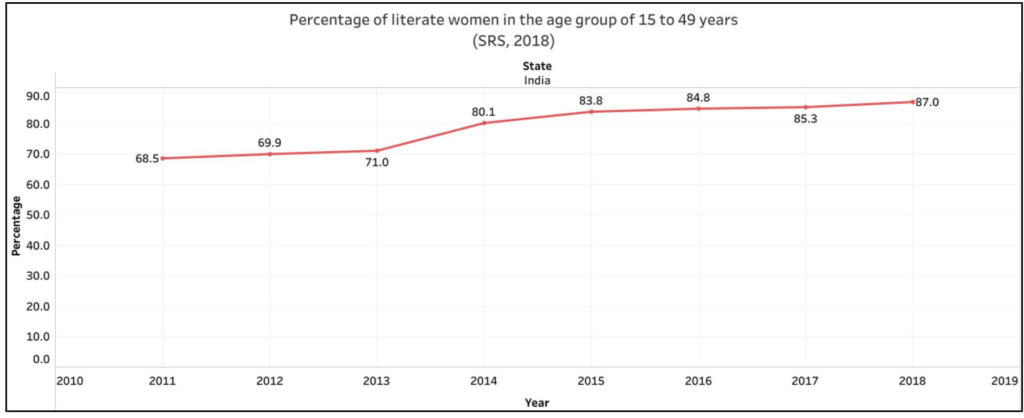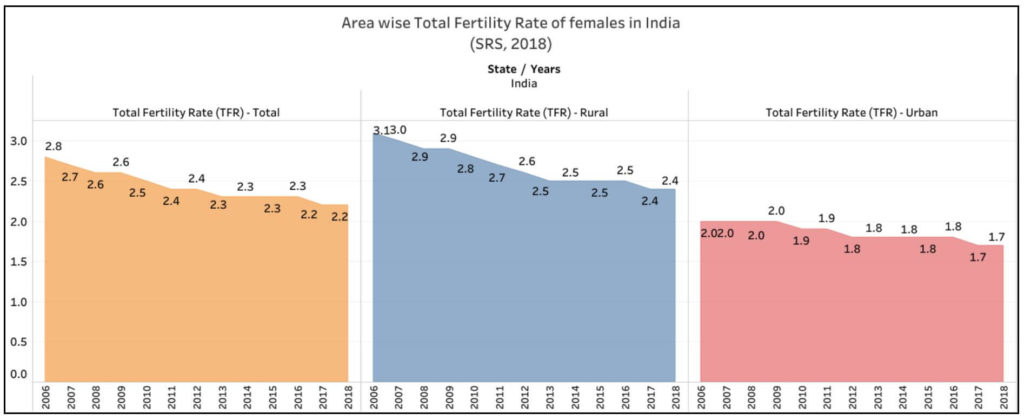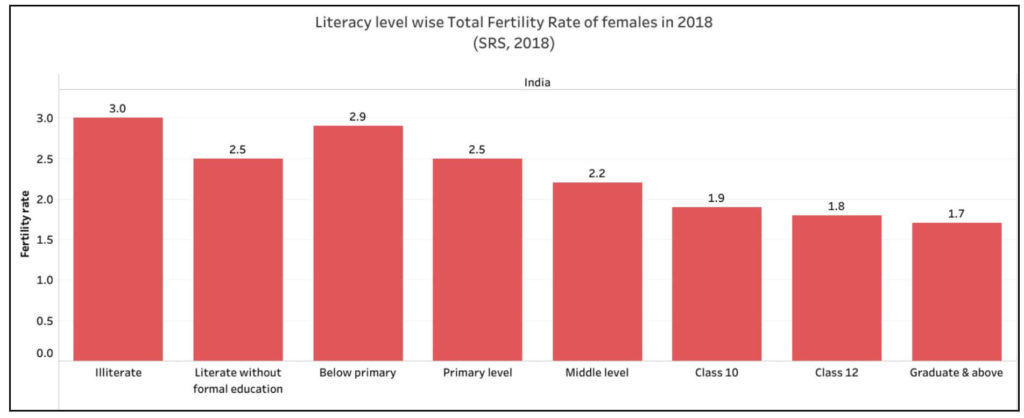The results of the Sample Registration System survey 2018 have been recently released. The data notes significant gains in female literacy. It also reveals the strong correlation between the literacy rate of women & fertility rates.
The Sample Registration System survey is an annual demographic survey published by the Registrar General of India. The survey gives an estimate of various demographic factors such as birth rates, death rates, fertility, and mortality rates, both at national level and state levels, indicating the progress in socio-economic development. Continuous enumeration of births and deaths in selected sample units is carried out by enumerators who are usually Anganwadi workers and Teachers. In addition to this, SRS supervisors carry out independent surveys every six months. The data recorded in both cases is matched. In instances where the data does not match or if there is partial difference, it is cross checked.
The sample unit for the survey in case of rural areas, is a village or a segment of the village if the population is more than 2000. In case of urban areas, the sampling unit is a census enumeration block with a population between 750 to 1000. At present, SRS survey is operational in 8847 sample units including 4961 rural and 3886 urban sample units across the country. Recently, the results of SRS 2018 were published.
People above the age of seven who can read and write in any language are considered literate
Those who are aged above seven and can read and write with understanding in any language are considered literate. Even those without any formal education who satisfy this criteria are considered literate. As of 2018, around 18.9% of the females had an education up to class X, 12.5% up to class XII, and only 9.8% had an education equivalent to graduate level and above. 4.9% of the females were literate but did not have any formal education. It is observed that the percentage of women who completed school education in 2018 was higher than that in 2017.
Female literacy rate among those aged between 15 to 49 years is increasing
Percentage of literate women in the age group of 15 to 49 years has been continuously increasing. Since 2011, the average literacy rate of women in this age group has increased from 68.5% to 87% in 2018. 13% of the women in the said age group fall in the ‘Illiterate’ category.

Fertility level is influenced by literacy level
Female education has a direct impact on fertility level. Certain studies suggest that higher female literacy level is important for population stabilization and better infant health. The impact of female literacy is independent of male literacy. Total Fertility Rate, abbreviated as TFR, is defined as the number of children born to a woman until the end of her child-bearing age. Higher the TFR, more is the number of children a woman may give birth to. Female literacy is expected to let women make more informed decisions. Not just that, women will also be able to support themselves and family, and will have more bargaining power, once educated. However, other parameters such as general health of population, government support programs, etc., also influence the fertility levels.
Total fertility rate is declining over the years
In India, as already seen above, the literacy rate among women in the 15-49 age group has been increasing. At the same time, TFR has been decreasing for the past few years. Traditionally, Rural areas have always recorded a higher TFR compared to urban areas. Between 2006 and 2018, the total TFR dropped from 2.8 to 2.2, implying that on average, a woman gave birth 3 children in 2006, and in 2018, it has reduced to 2. While the TFR in urban areas dropped from 2 to 1.7, the same in rural areas dropped from 3.1 to 2.4 during the 13 years.

As education level among women increases, a decline in TFR is witnessed
As demonstrated in the subsequent chart, the TFR for women reduces with education. The TFR among illiterate women stood at 3. This means that on an average, an illiterate woman had three children. The same among women who were literate and did not have any formal education was 2.5. Among those who had education, the overall fertility rate of women with education below primary level stood at 2.9 while those with primary level education had TFR of 2.5. Women with education up to middle level had a fertility rate of 2.2. and those educated beyond class X had TFR below 2.

Kerala and Himachal Pradesh have higher female literacy levels and lower fertility rates
State-wise data reveals that eight (8) states among the larger states have female literacy rate more than 90%. Kerala continues to record the highest female literacy rate. In 2016, Kerala’s female literacy rate was 99.2%, which increased to 99.3% in 2017 and 99.5% in 2018. Meanwhile, Bihar, Jharkhand and Uttar Pradesh continue to record the worst female literacy rate even though the states have reported a substantial improvement over the previous years. Bihar, Jharkhand, and Uttar Pradesh recorded female literacy rates of 76.5%, 77.4%, and 79.7% respectively as per SRS 2018.
The same is also reflected in the TFR recorded in the states. It is evident that states which have recorded lower female literacy rates have a higher TFR. Bihar, Jharkhand, and Uttar Pradesh have recorded a TFR of 3.2, 2.5, and 2.9 respectively while Kerala and Himachal Pradesh which have highest female literacy level of 99.5% and 98.8%, have a TFR of 1.7 and 1.6 respectively.

Higher Fertility Rate & increasing population inhibit development
Increasing population & higher population growth rate is a cause for concern for India. While some argue that increased population provides more working age population and creates a big consumer market, the disadvantages far outweigh the advantages.
With increasing population & higher fertility rate, health risks for children and their mothers increase. It is also seen that in countries with higher fertility rates, economic growth is stunted. The implications on the environment should not be neglected as well. A study by World Bank in 2010 also highlighted how the countries with higher fertility rates lagged behind in important development indicators.
All this means that education of women which leads to low fertility rates is necessary for a healthy & prosperous nation. Only then, more women can take part in economic activities and make informed choices, leading to greater socio-economic development of country.
Featured Image: Sample Registration System survey 2018


